Oenothera spp.
Whether it’s the blooms of an evening primrose, a pizza delivery place with extended hours, or a 24/7 gas station during a well-hydrated road trip, anything that’s “open late” can be an absolute blessing.
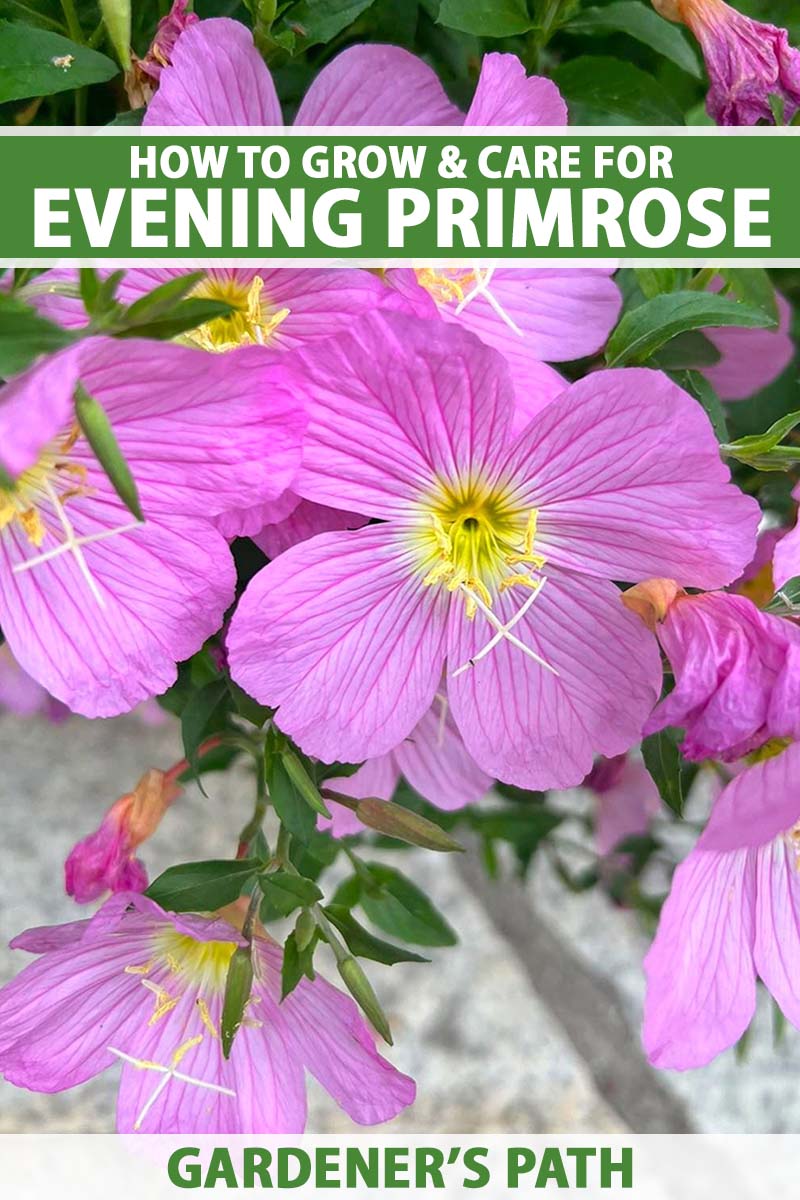
We link to vendors to help you find relevant products. If you buy from one of our links, we may earn a commission.
In the case of Oenothera, it definitely is. With stunning flowers that open up later in the day than most other blooms, evening primroses certainly live up to their name.
Add a variety of beautiful forms and a robust toughness to the mix, and Oenothera species absolutely warrant being added to your garden.
“But how do I propagate these plants?” “How should I care for them afterwards?” “And how do evening primroses fit into humanity’s body of knowledge on evolutionary biology?”
You’re probably brimming with questions, so we’ve whipped up a growing guide just for you. You’ll have your answers, dear reader… and more.
Let’s get it started. Here’s everything we’ll cover, up ahead:
What You’ll Learn
What Are Evening Primroses?
Evening primroses are about 145 species of herbaceous flowers from the Oenothera genus, which belongs to the Onagraceae, or the evening primrose family.
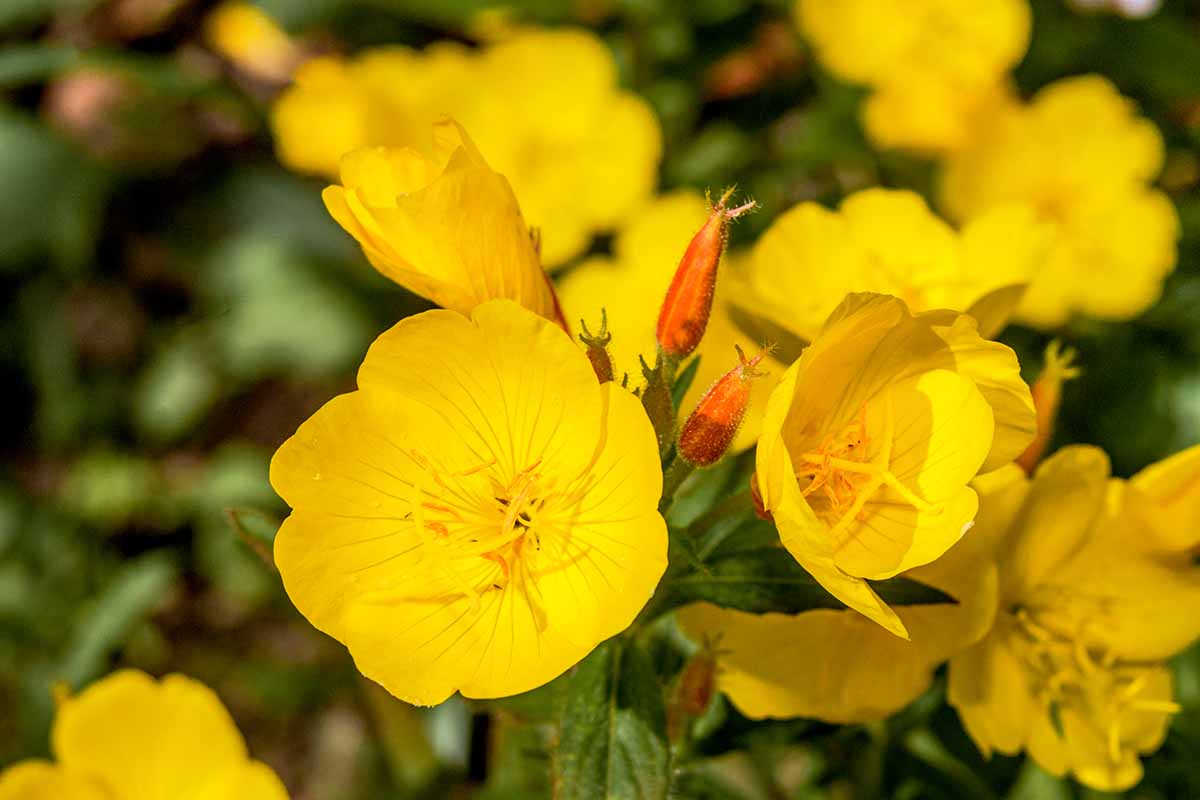
Depending on the variety, evening primroses – also known as coffee plants, golden candlesticks, and a host of other nicknames, depending on the species – can be annuals, biennials, or perennials.
Suitable growing regions range across USDA Zones 3 to 11.
Oenothera species are native to North and South America, although they’ve naturalized in Europe and many other parts of the world.
With a wide range of habitats and climates that they call home, evening primroses are pretty tough flowers, with built-in durability against many environmental stressors that would make short work of weaker plants.
Oenothera plants display large, goblet-like flowers in white, yellow, red, pink, or purple hues, each with four petals.
Some species flaunt fragrant blooms, while others are pretty much scentless. Depending on the variety, they may bloom from spring to fall.
Evening primrose is so named for its habit of only showing its attractive blooms late in the day in a manner similar to four o’clock flowers, leaving them open until around mid-morning the following day, at which point the flowers expire.
But while each individual bloom doesn’t last for very long, new flowers will take the place of old ones throughout the blooming period.
Since the flowers are open during the later hours, they’re often visited by pollinators of the night, including various types of moths and vespertine bees.
After pollination, the blooms eventually give way to four-capsuled, seed-bearing fruits.
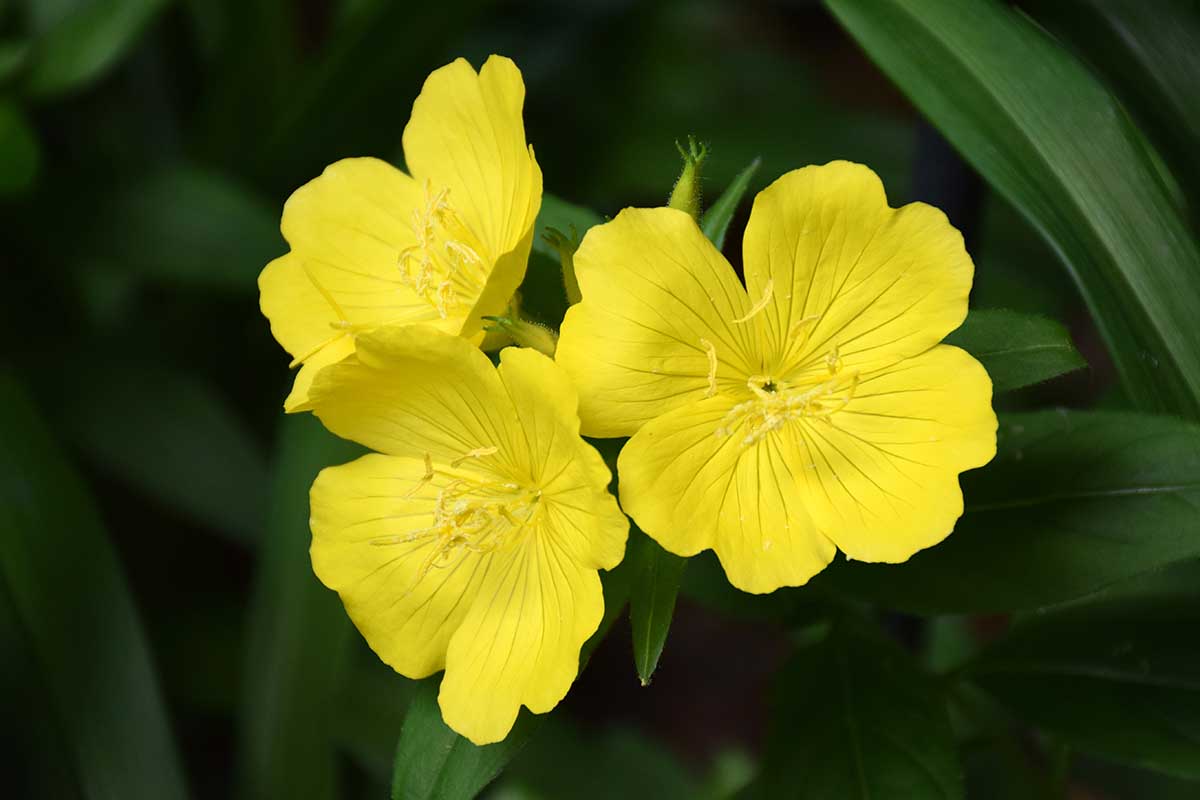
Some varieties have an upright growth habit, reaching a height of six feet with a spread of two feet, whereas others are used as ground cover or in container plantings, growing no higher than six inches.
Across the majority of the genus, the green leaves are elliptical to lance-shaped.
Certain varieties have the tendency to grow rather aggressively, and particular locales may list those types as invasive.
Always check your area’s rules and regulations prior to selecting a species or cultivar and planting location!
Cultivation and History
Evening primroses aren’t just pretty, they can also be useful.
Native Americans used the whole of O. biennis for food and treating bruises, and also used its roots specifically for treating hemorrhoids.
The leaves were traditionally used for tending to minor wounds, gastrointestinal issues, and sore throats.
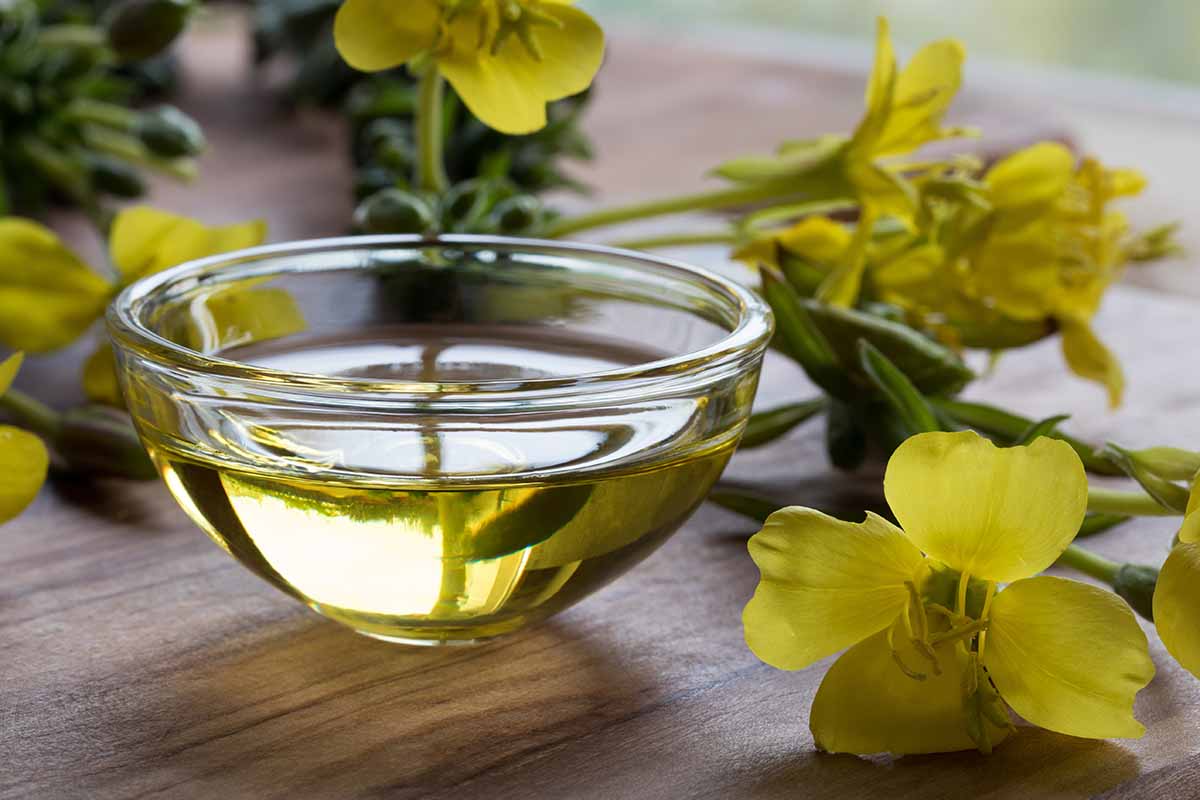
In the 1600s, Oenothera plants were exported to Europe, where they have since naturalized.
There, O. biennis found many different medicinal applications, earning nicknames such as “king’s cure-all” and “fever-plant.”
Today, oil pressed from the seeds of O. biennis is marketed in capsule form to help a number of conditions including eczema, rheumatoid arthritis, premenstrual syndrome, and osteoporosis.
The gamma linolenic acid — aka GLA, a type of omega-6 fatty acid — contained within the oil is used by the body to regulate blood pressure and to keep the immune system functioning well.
The roots, which are said to have a light peppery taste similar to salsify, can be eaten raw or prepared as you would any root vegetable.
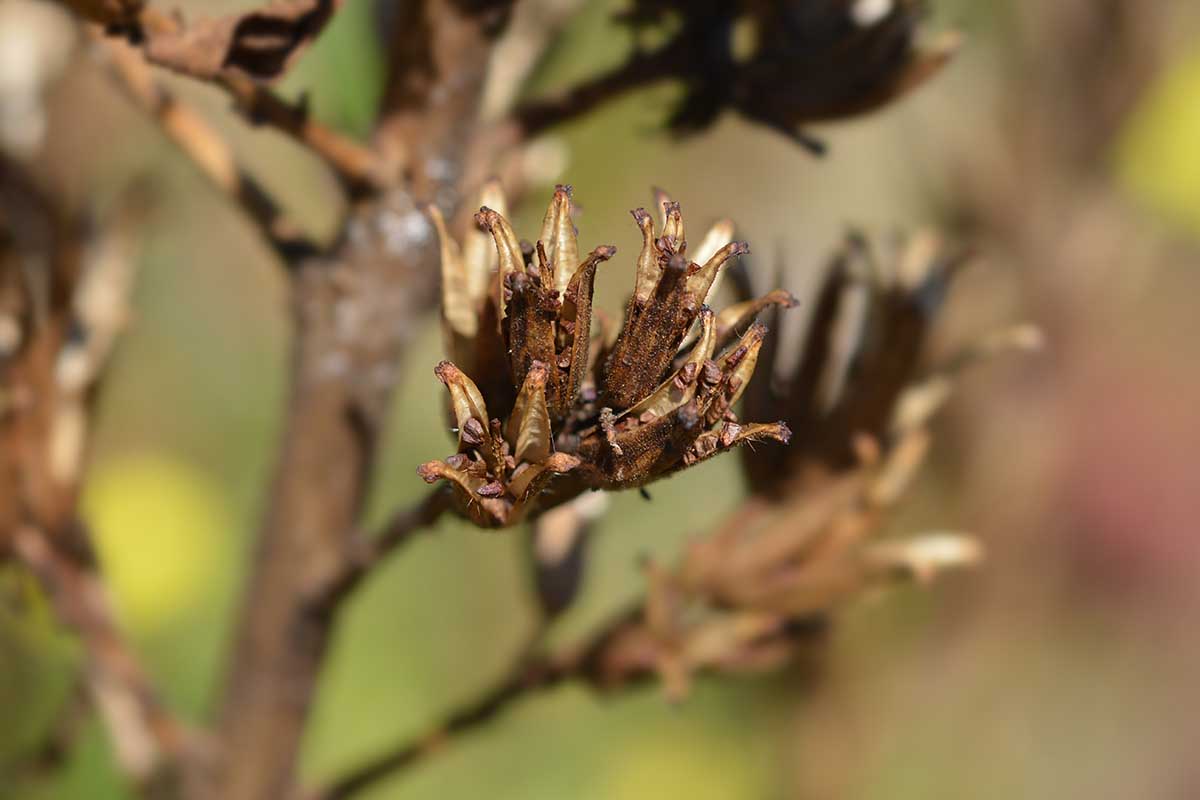
Birds, perhaps seeking a little omega-6 of their own, enjoy eating the plant’s seeds, as do some humans who use them as one might use poppy seeds.
Here’s a question for you, though: what do evening primrose flowers and the X-Men have in common?
Answer: an association with mutation.
Let’s back up a bit.
In the late 1800s, Dutch botanist and geneticist Hugo de Vries noticed significant differences between wild and cultivated varieties of O. lamarckiana.
At the time, he thought these differences were due to mutations that rapidly and observably changed traits between generations.
Nowadays, we know that Oenothera plants don’t always follow the typical rules of gene inheritance, and that they’re also easily prone to hybridization with other species.
Meaning, Oenothera offspring can look significantly different from their parents, and this has less to do with mutations and more to do with cross-breeding, and the unusual way that these plants can pass down genes.
But de Vries didn’t know what we now know about Oenothera genetics.
Observing spontaneous new forms and varieties while cultivating evening primroses, he used these flowers and his observations to form his mutation theory, which proposed that new species are rapidly formed from sudden and unexpected mutations.
This theory clashed with Darwinian ideas about evolution, which argued that a gradual process of natural selection is what drives evolution.
But de Vries’ efforts weren’t for nothing, far from it.
As the father of mutation theory, his work introduced the idea of mutations to evolutionary science, paving the way for future scientists to discover that mutations didn’t drive evolution, but rather, provided more genetic variation for the natural selection process to work with.
So, in a roundabout way, we partially owe our knowledge of mutations – and evolution as a whole – to the humble evening primrose. How cool is that?
Evening Primrose Plant Propagation
Want some Oenothera of your own? I thought you might.
Evening primroses are best propagated from seed, from divisions, or via transplanting.
From Seed
As you can imagine, sowing seeds requires seeds, which can be harvested, purchased, and/or acquired from a friend.
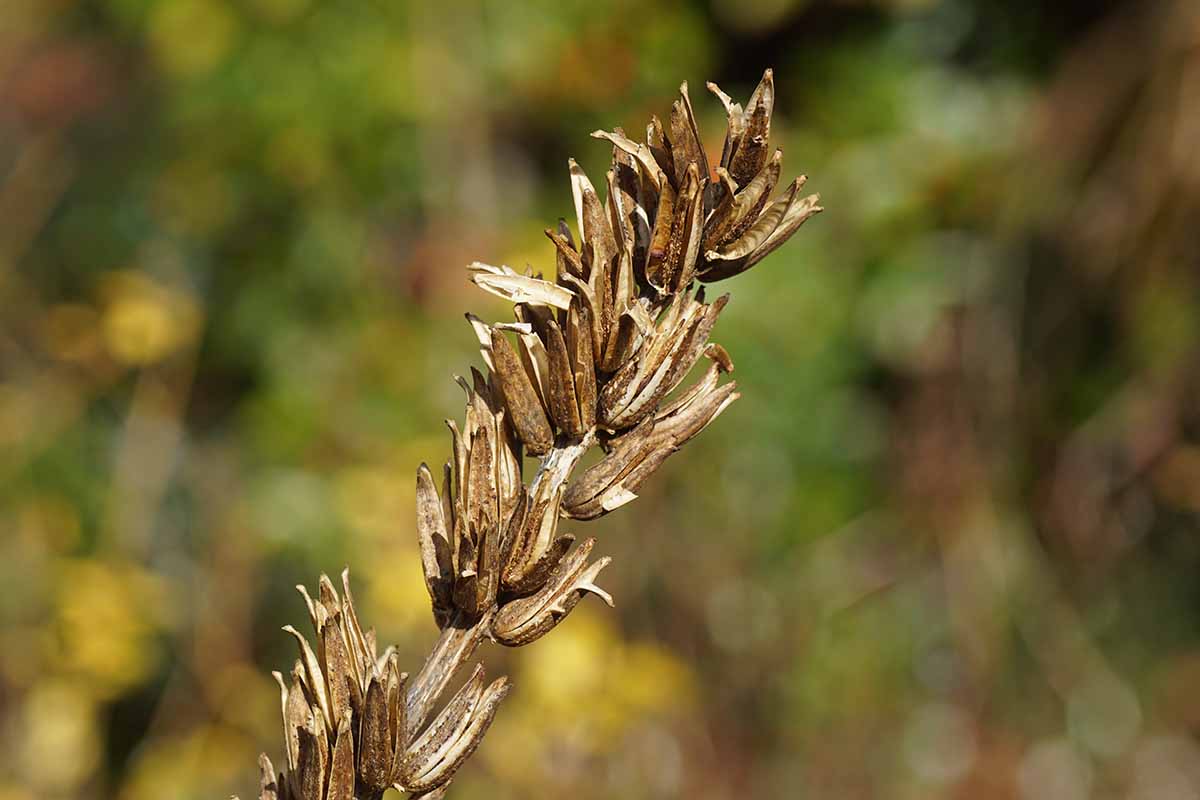
To harvest some seeds for sowing, you should remove the fruits once they develop a brown, papery look.
But make sure to pluck them before the fruit tips open, lest the seed spill on the ground.
The fruits will require frequent check-ups so you can pluck them at the right time. When it’s time, puncture the tip with a sharp and sterile blade, open up the fruit, and gently shake out the seeds.
As a workaround to regular monitoring, you could cover the fruits with gauzy organza bags, which will catch the seeds whenever they drop on their own.
The material is densely-meshed enough for catching seeds, yet open enough to allow for light exposure and airflow.
Have your seeds? You can either sow them outdoors in the fall, or cold-stratify them indoors before outdoor sowing the following spring.
For sowing seeds in autumn, do so just below the soil line in well-draining, moderately fertile garden soil with a pH of 6.0 to 7.0. If you want to be on the safe side, sow the seeds in groups of four.
Space the groups of seeds as far apart as your chosen variety’s typical width. Keep the soil around the seeds moist until freezing temperatures set in. At this point, your work is done until after the final frost date in spring.
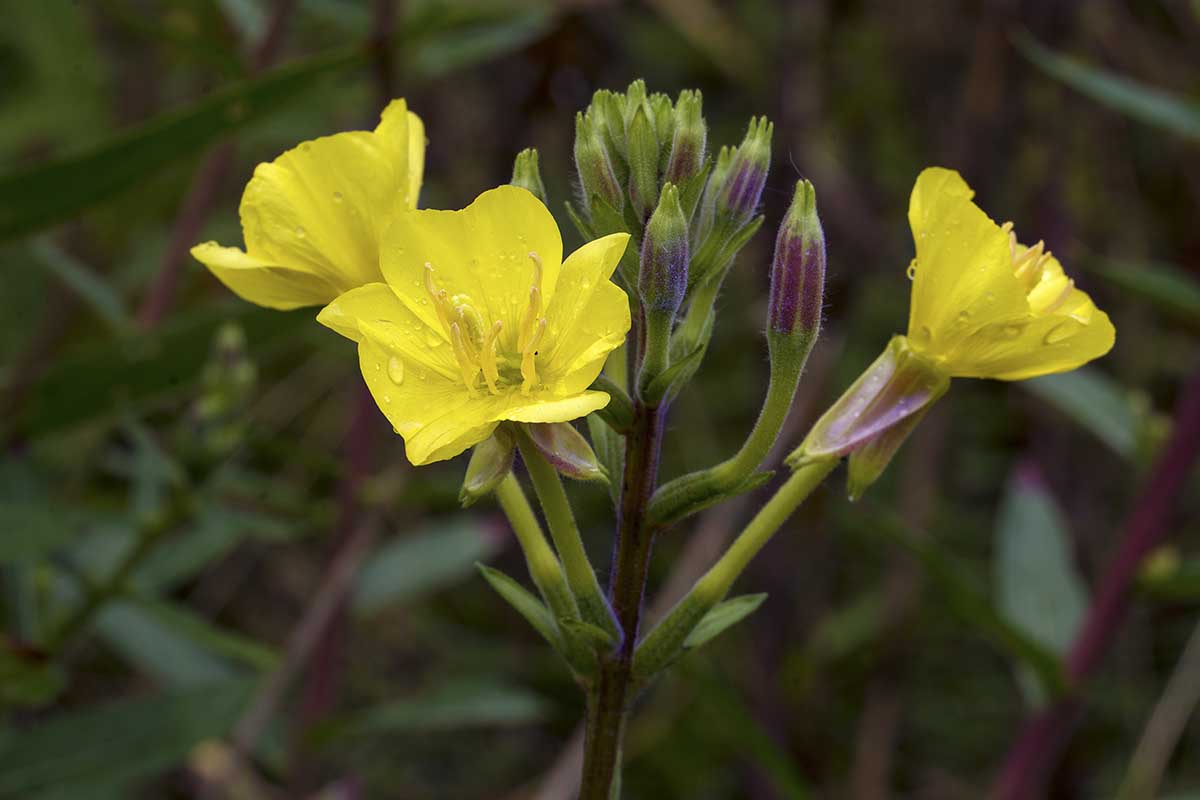
Before you sow seeds outdoors in spring, you’ll have to cold-stratify them.
Two months or so prior to the planned planting date in post-frost spring, put the seeds in a plastic bag of moist sand.
Keep the bag in the fridge for 60 days – making sure to keep the sand moist all the while, then sow them outdoors using the above planting protocol.
Alternatively, you can also sow seeds directly into outdoor containers rather than the ground.
If you go the container route, plant your four-seed groups into their own three- to four-inch containers, each filled with a 50:50 mix of peat moss and perlite.
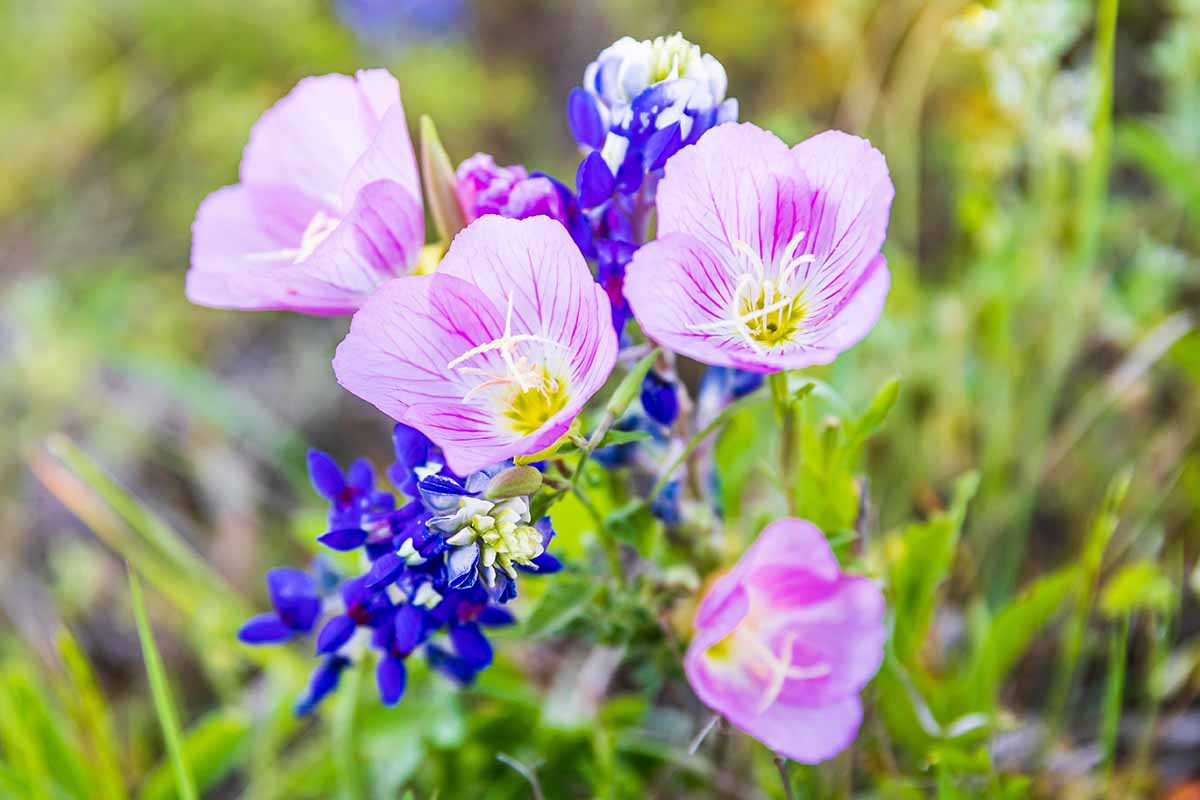
Care for them like you would in-ground seeds, and be sure to repot them as needed to keep the plants an inch or two away from the container’s sides.
Not every species is ideal for container growing, especially the ones with long taproots. For any species you consider, make sure you have an idea of what the mature root system will look like!
From Divisions
Not every Oenothera species likes being divided, O. macrocarpa being one of them.
But if your chosen perennial species can handle it, division is a quick and efficient way to acquire more evening primroses.
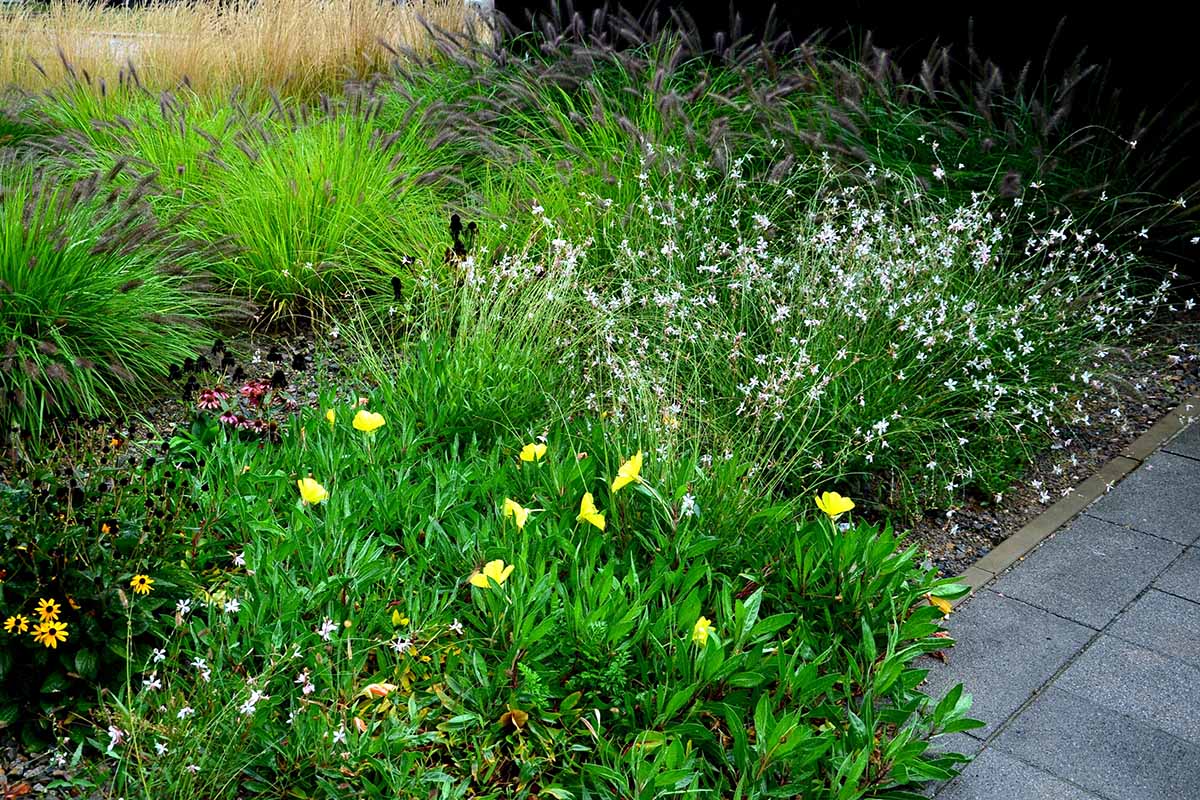
Timing this depends on when your chosen species blooms. Early bloomers should be divided promptly after they finish blooming, while later bloomers should be divided in early spring.
This ensures that a plant’s strength isn’t sapped right before it flowers.
Once it’s division time, dig a circle around and gently lift out your chosen specimen, making sure to handle the root system with tender, loving care.
Lay out the specimen over a tarp, and turn that TLC into tough love by slicing the plant apart into equally-sized sections with a sharp, sterile blade.
At this point, each division is ready for transplanting!
Via Transplanting
Prior to transplanting, prepare a planting site or adequately-sized and well-draining container for each transplant.
Dig holes deep enough for their root systems and wide enough to give yourself some elbow room in which to work and the roots to spread.
Then, carefully lower each transplant into its planting site.

If you want your transplants to start off with a bit of added fertility, feel free to mix some organic material in with the dug-out soil. Backfill the holes and water the transplants in.
The soil will need to be kept moist until the transplants establish themselves in a year or two. Moist, not saturated – you don’t want to have a case of root rot on your hands!
How to Grow Evening Primrose Flowers
Obviously, these recommendations are intentionally kept general since we’re covering a whole genus of plants.
I’d definitely recommend double-checking the particular requirements of your chosen species!
Climate and Exposure Needs
The aforementioned hardiness within USDA Zones 3 to 11 spans the entire genus – for each of those zones, there’s at least one type of Oenothera that can work.
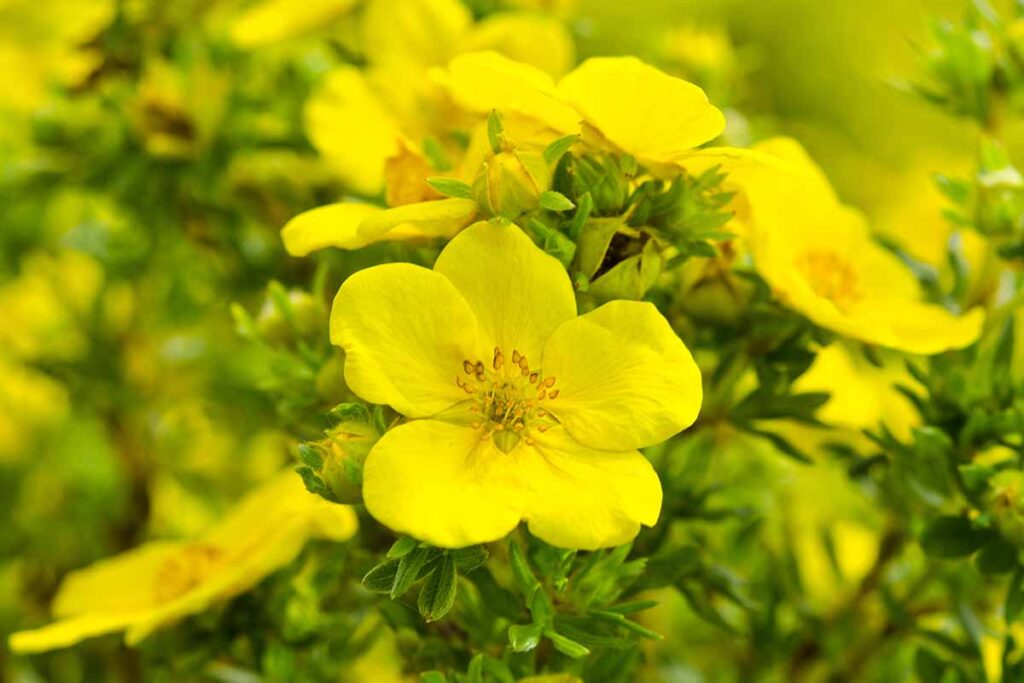
Evening primrose flowers will do well in full sun to partial shade, depending on the variety.
Soil and Water Needs
Oenothera plants prefer well-draining soils within a standard pH range of 6.0 to 7.0, but they’ll tolerate higher pH levels.
They do fairly well in poor soils, but they really thrive in soils that have been amended with some organic matter.
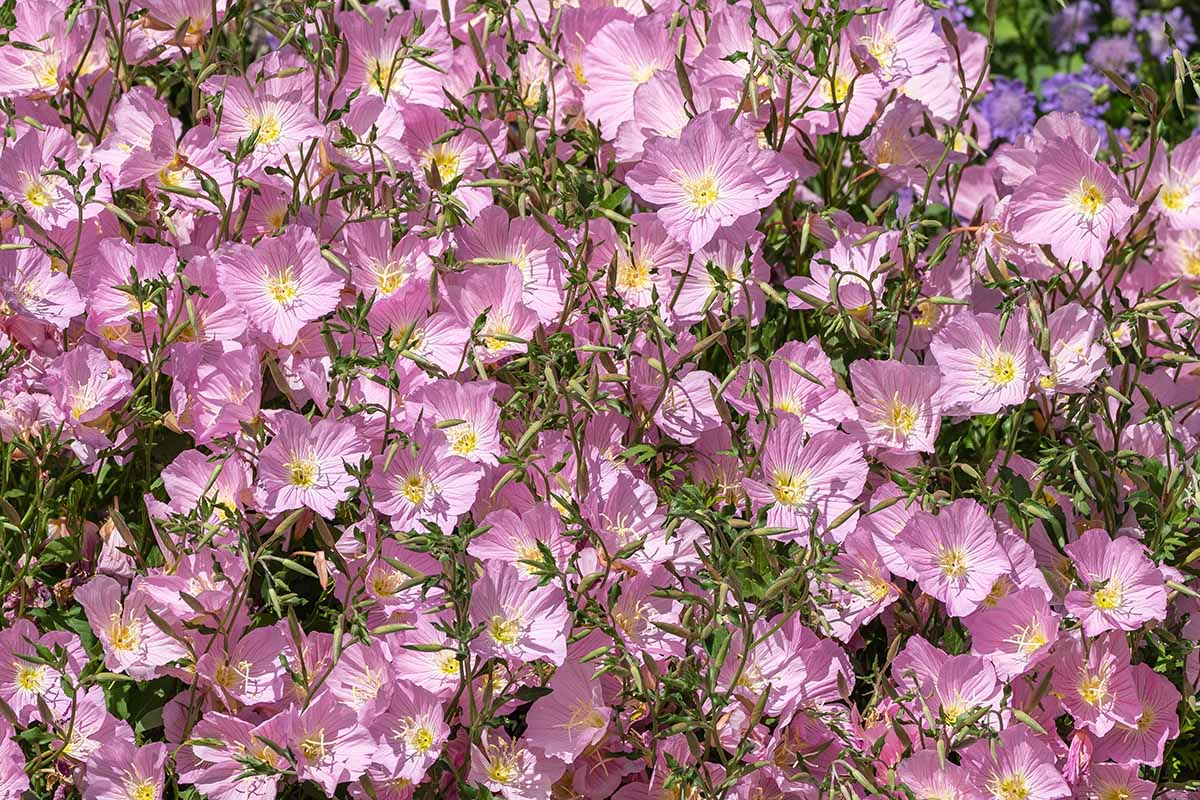
Keep fertility up by working an inch or two of organic matter into the root zone of your plantings each spring.
Most varieties of Oenothera are quite drought tolerant, requiring little supplemental watering. You could honestly let the rain do all the watering for you, and your evening primroses should do just fine.
But there’s a significant difference between “fine” and fine, if you catch my meaning… and optimal irrigation entails watering whenever the soil completely dries out.
Growing Tips
- Provide full sun to partial shade, depending on the species.
- Well-draining soil is essential.
- Ideally, water whenever the soil is totally dry.
Pruning and Maintenance
As these plants are primarily known for their flowers, you’ll get a lot more out of their blooming period if you deadhead the blooms as soon as they’re spent.
Depending on the variety, a bit of mulch could be helpful for maintaining moisture and preventing weeds, adding to the aesthetics of your garden as well.
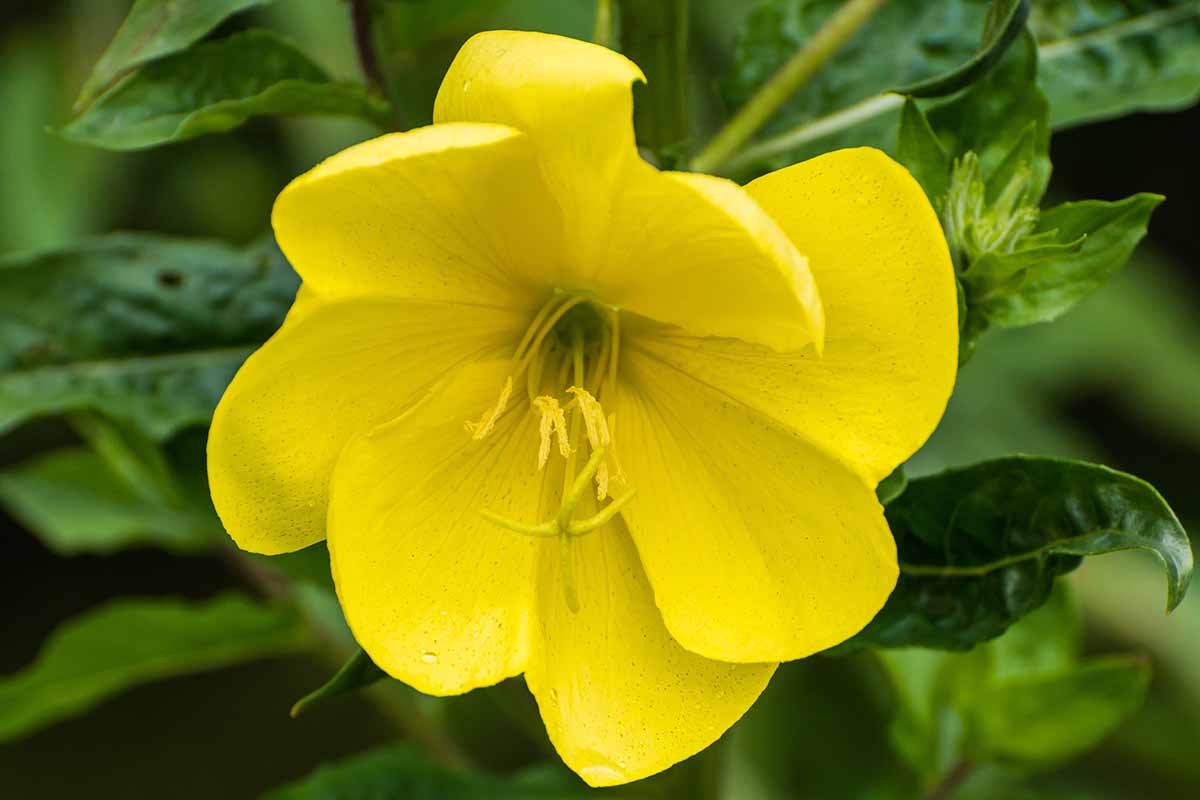
If your specimens are spreading and growing more aggressively than you’d like, feel free to pull any undesired ones that happen to pop up.
To reduce the plant’s growth rate and make things a bit easier for yourself, you can actually cut back on irrigation and let the rainfall do most, if not all, of the watering.
Containerized evening primroses should be repotted as needed to prevent root bindage – a pot that’s about two inches wider than the root system is the standard to shoot for.
Evening Primrose Species to Select
There are many species of Oenothera out there… but which to choose? “Best” is subjective, of course, but I’m confident in recommending these bad boys:
Common
Common evening primrose, or O. biennis, can grow as tall as six feet with a spread of about two to three feet.
Hardy in USDA Zones 4 to 9, this biennial solely produces leafy stalks in the first year.
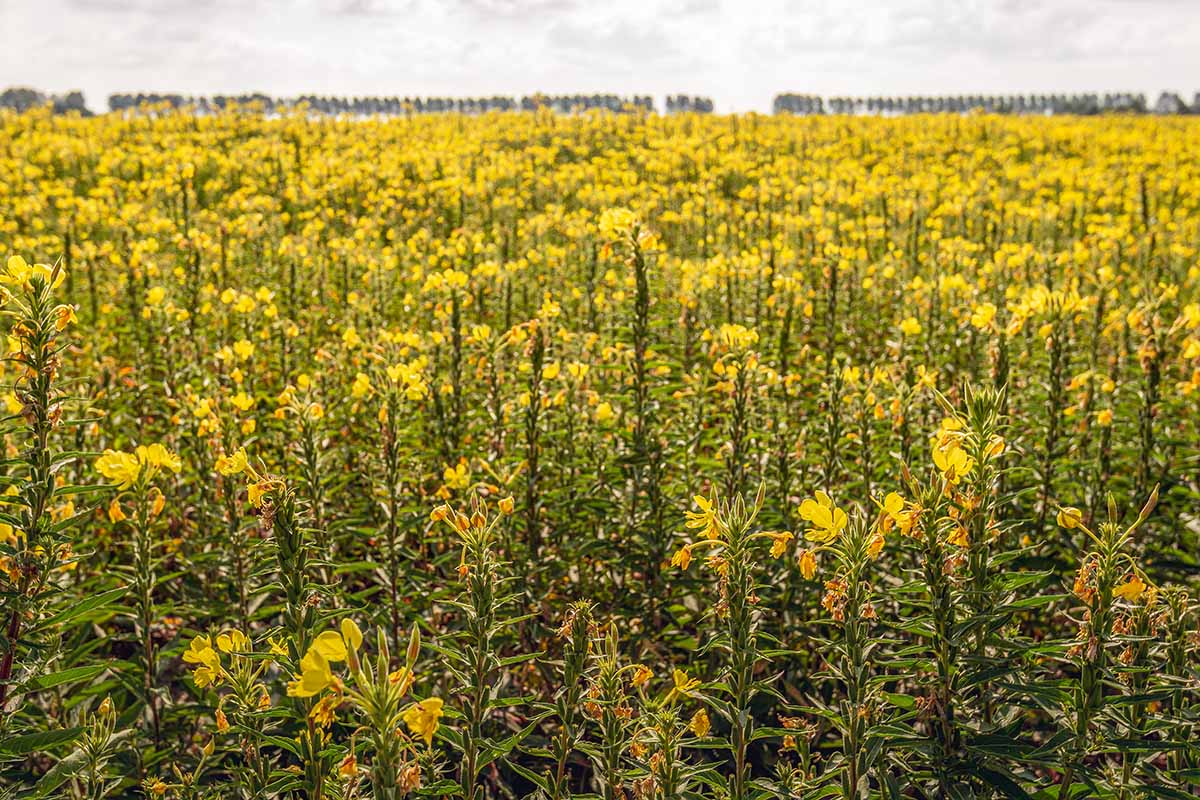
The second year’s stalks, though, are adorned by large, lemon-yellow flowers before giving way to fruit capsules.
Blooming from summer to fall, O. biennis is native throughout the United States and Canada, and is often found growing in prairies, thickets, and glades, and along roadsides.
And although it may be common, it’s certainly far from boring.
Mexican
O. berlandieri, or Mexican evening primrose, is a spreading perennial that only grows to a height of about 18 inches.
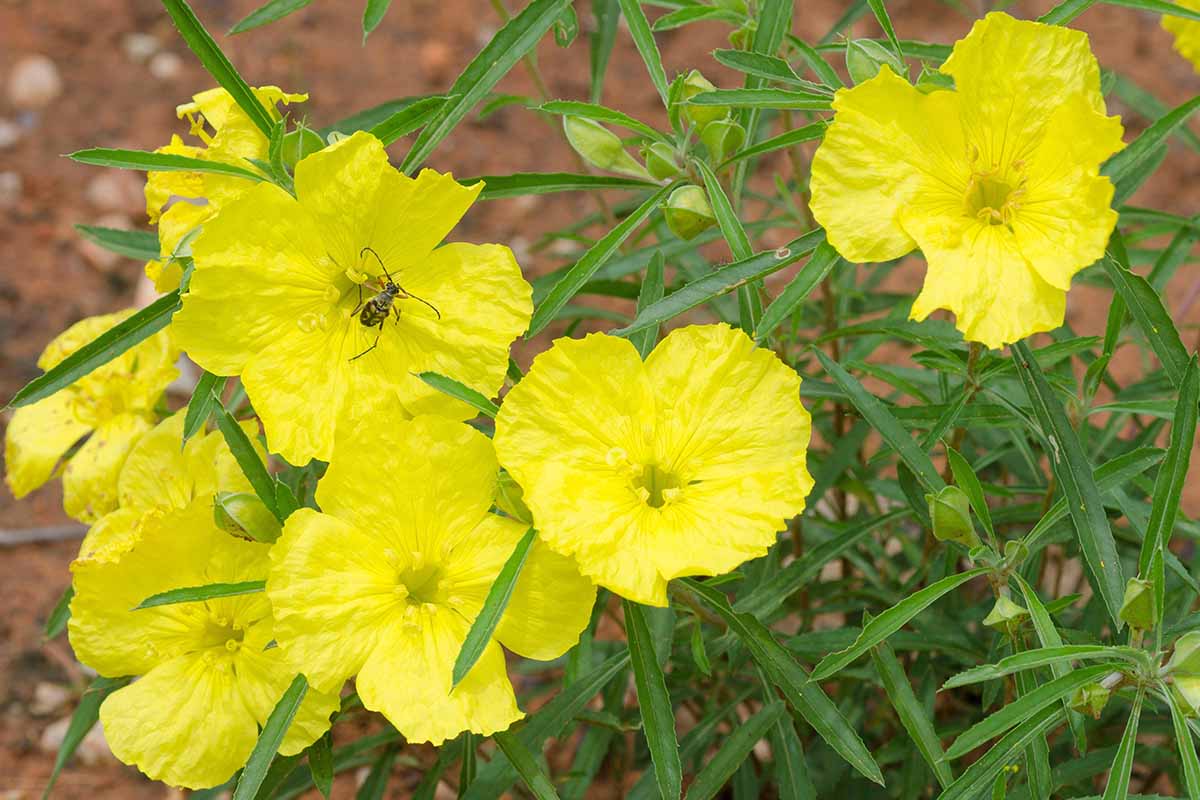
Native to Missouri, Nebraska, Kansas, Oklahoma, Texas, and Mexico, this plant will grow in full sun while tolerating infertile soils and minimal water, even more so than many other evening primroses.
Hardy in USDA Zones 5 to 8 and with pink to white flowers that bloom throughout spring and summer, the Mexican evening primrose is among the toughest of the tough.
Missouri
As a native Missourian, I’m a bit biased towards this one.
A native of the southern and central United States and hardy within USDA Zones 3 to 7, O. macrocarpa is a sprawling perennial that reaches heights of nine to 12 inches and spreads 12 to 18 inches.
With beautiful yellow blooms that emerge in spring and summer, the Missouri evening primrose is low in profile, yet high in beauty.
Especially when you consider its fruits, which are especially large for an Oenothera and perfect for use in dried floral arrangements.
You can learn more about Missouri evening primrose in our guide.
Showy
Hardy in USDA Zones 4 to 9, the showy evening primrose certainly brings the goods, aesthetics-wise.
Aka O. speciosa, it grows one to two feet tall, spreading one to one and a half feet wide, and flaunts beautiful blooms from late spring to summer.
The flowers are white at first, but adopt a rosy pink hue over time as the plant matures.
Native to Mexico and the southwestern United States, the showy evening primrose is truly a flashy beauty, with evolving color that simply can’t be ignored.
For a packet of O. speciosa seeds, visit True Leaf Market.
Managing Pests and Disease
For the most part, evening primroses aren’t prone to many diseases or pests. But there are some potential problems that you should be aware of.
Insects
As insects move from plant to plant, they can vector a plethora of harmful diseases. So by managing pests, you’ll also be managing disease to a degree.
Leafhoppers
Leafhoppers are quarter-inch-long insects from the Cicadellidae family, and they usually congregate on stems and leaf undersides.
The most common symptom of their presence is leaf stippling, i.e. small, pale, and discolored feeding spots.
If severe, this feeding damage can cause leaves to turn yellow, brown, and die. Leafhoppers also excrete honeydew, which can attract ants and lead to black sooty mold formation.
Natural enemies such as assassin bugs, lacewings, and ladybugs can make short work of these pests, along with sprays of horticultural oil or insecticidal soaps during the growing season.

Find 32 ounces of ready-to-spray insecticidal soap from Bonide, now on Amazon.
Lygus Bugs
Adult Lygus species are about a quarter-inch in length, with oval-shaped bodies and a triangular lobe above the wings.
The nymphs are smaller, with a more rounded form and lighter-colored bodies. The colors vary between species, ranging from brown or black to yellow, red, or green.
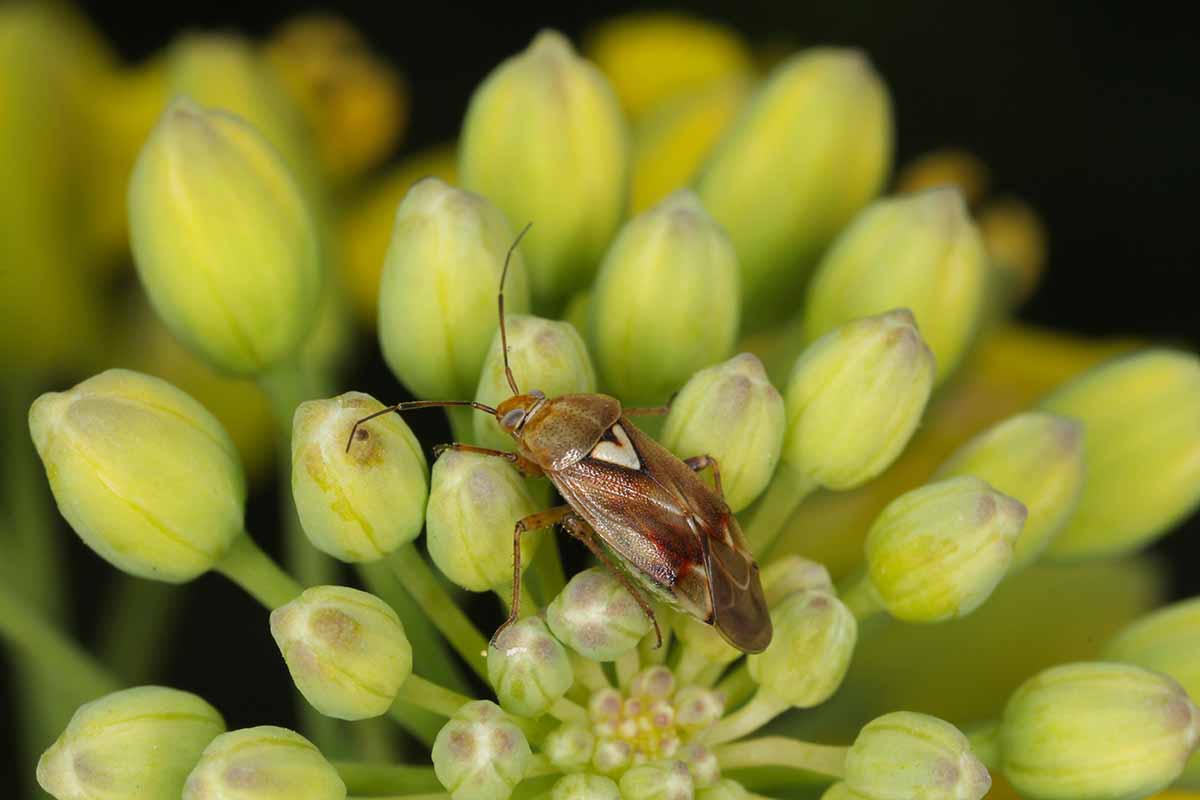
After overwintering in plant debris, adults emerge in early spring to feed on buds and shoots, mate, and lay eggs in the tissues of host plants.
Come summer, nymphs hatch from the eggs, who feed from plants as they grow and mature.
In a growing season, two to four generations may be born, the last of which overwinter during the dormant season to start the cycle anew the following year.
With piercing-sucking mouthparts, lygus bugs extract vital fluids from plant cells.
This hinders seed set and plant maturation, along with causing bud drop or flower abortion, which can be a real problem for blooms as beautiful as an evening primrose’s.
Regularly sweep your plants for these pests and signs of their presence. Remove nearby weeds and plant detritus, and use insecticidal soap as needed to smother these pests.
Many beneficial insects such as minute pirate bugs, ladybugs, lacewings, and assassin bugs are known to consume lygus bugs. Many of these bugs are available for purchase at Arbico Organics.
Japanese Beetles
Interestingly, some gardeners plant Oenothera as a trap plant to attract Japanese beetles away from other, “more desirable” plants such as roses.
But when beautiful evening primroses are the goal, the penchant of these pests can be quite annoying.
As an adult, Popillia japonica is about a third of an inch to a half-inch long, with bronze wing covers alongside a metallic green head and thorax.
The C-shaped grubs are cream-colored, with tan heads and easily visible legs.
These invasive pests overwinter as grubs in the soil prior to pupating into adults in spring.
Emerging from the ground fully grown in summer, Japanese beetles feed on plant foliage, flowers, and fruits, and they are capable of flying for miles to do so.
They also mate and lay eggs in the soil, which continues the life cycle.
As you can imagine, feeding holes left in leaves and flower petals don’t look all that great, and they hinder plant health to boot.
The grubs can also chew on roots, leading to tissue death above the soil line.
An effective method of physical control, “soapy death” entails picking or flicking the bugs into a bucket of soapy water, which drowns them.
If you catch a pair of bugs mating, don’t be shy about going for double points – I imagine there are worse ways to go.
Make sure to use soapy death in the morning or evening, when the bugs aren’t as spry.
Alternatively, you could use neem oil as a deterrent, but it does require repeat applications every few days or so.
Learn more about how to manage Japanese beetles in our guide.
Disease
To keep disease risk down to an absolute minimum, make sure to use sterilized gardening tools and disease-free soils.
Leaf Spot
Caused by various types of fungi and bacteria, leaf spot results in the formation of brown and black spots on foliage, which can hinder photosynthesis and reduce plant aesthetics.
Prune away and dispose of leaves if the majority of their surfaces are afflicted.
In the case of fungal leaf spot, copper fungicides can work as a preventative measure if this issue has been a known problem in your garden in the past.
Powdery Mildew
A fungal disease of many different plants, powdery mildew leads to the formation of a downy white powder on plant surfaces, which is primarily a cosmetic concern.
But depending on the severity, additional symptoms include necrotic lesions, stunted growth, leaf rolling, and even death in extreme cases.
As high ambient humidity promotes disease development, it’s important to properly space plants and avoid overhead irrigation.
Rake up nearby plant detritus to interfere with fungal life cycles, and cut away any severely afflicted tissues for disposal.
Root Rot
With drought tolerance often comes an inability to handle excess soil moisture, and Oenothera is no exception.
Whether it’s caused by too much watering, poor drainage, or a combination of both, oversaturated soils don’t allow the roots to take up as much oxygen.
This suffocation tends to leave the roots necrotic and mushy, followed by nasty aboveground symptoms in the shoots such as chlorosis, wilting, and even death.
Preventing root rot requires reducing excess water, whether by limiting irrigation, improving soil drainage, or both.
If your plants are already afflicted, dig up and remove the rotted roots. If the majority of the root system is rotted, then the plant should probably be pitched.
Best Uses for Evening Primrose Flowers
With an assortment of species to choose from, there’s an evening primrose for almost every garden.
Along walkways and borders, in a raised bed or container, and as a ground cover or a grouping of specimens, species of Oenothera offer a ton of planting options.
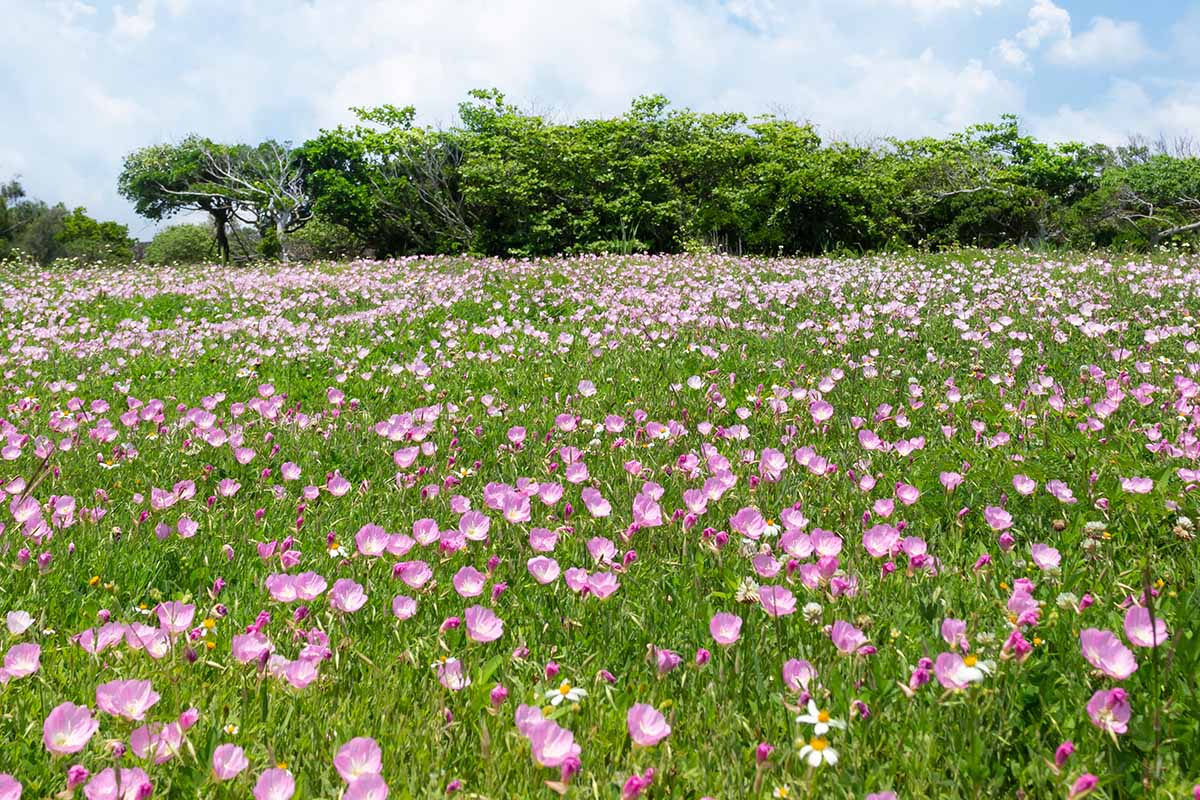
Regardless of the species, the late-day appearance of the flowers is a sight to behold.
You could try your hand at using these plants for medicinal or culinary purposes, if you so desire.
But it definitely pays to be cautious and do the necessary research before putting any part of a plant from the garden in or on your body.
Quick Reference Growing Guide
| Plant Type: | Herbaceous flowering annual, biennial, or perennial | Flower/Foliage Color: | Pink, purple, red, white, yellow/green |
| Native to: | North and South America | Maintenance: | Low |
| Hardiness (USDA Zones): | 3-11 | Tolerance: | Alkaline soils, drought, heat, infertile soils, partial shade, rocky soils |
| Bloom Time: | Spring-fall | Soil Type: | Average to lean |
| Exposure: | Full sun, partial shade | Soil pH: | 6.0-7.0 |
| Time to Maturity: | 4-6 months | Soil Drainage: | Well-draining |
| Spacing: | Depends on species | Attracts: | Birds, butterflies, moths, specialized bees |
| Planting Depth: | Slightly below soil surface (seeds), depth of root system (transplants) | Uses: | Borders, containers, cut flowers, ground covers, groupings, raised beds, rock gardens |
| Height: | 6-72 inches | Order: | Myrtales |
| Spread: | 12-36 inches | Family: | Onagraceae |
| Water Needs: | Low | Genus: | Oenothera |
| Common Pests and Disease: | Leafhoppers, lygus bugs, Japanese beetles; leaf spot, powdery mildew, root rot | Species: | Biennis, berlandieri, macrocarpa, pallida, speciosa |
The Evening Primrose: Plenty of Pros
If you’re like me, then you’ve probably used a pros and cons list to make decisions.
If you’re considering a species of Oenothera for your garden, here’s a spoiler warning: that list is gonna be quite imbalanced towards the “pros” side.
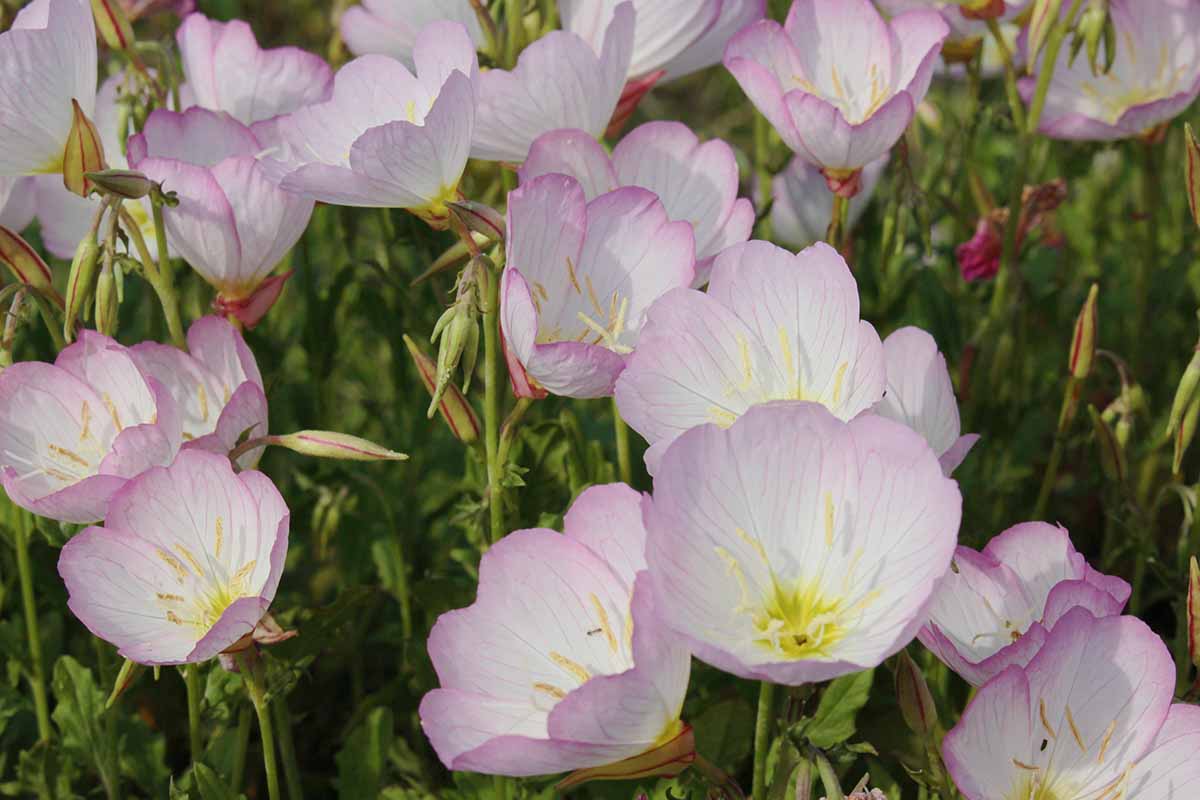
Evening primroses are stunning, tough, and versatile plantings for your landscape – that’s a claim I’ll swear by. But the only way you’ll know for sure is if you grow them for yourself. So what are you waiting for?
Do you have anecdotes, questions, or experiences of your own to share? The comments section awaits.
Looking for other drought-tolerant flowers to add to the garden? Lo and behold:
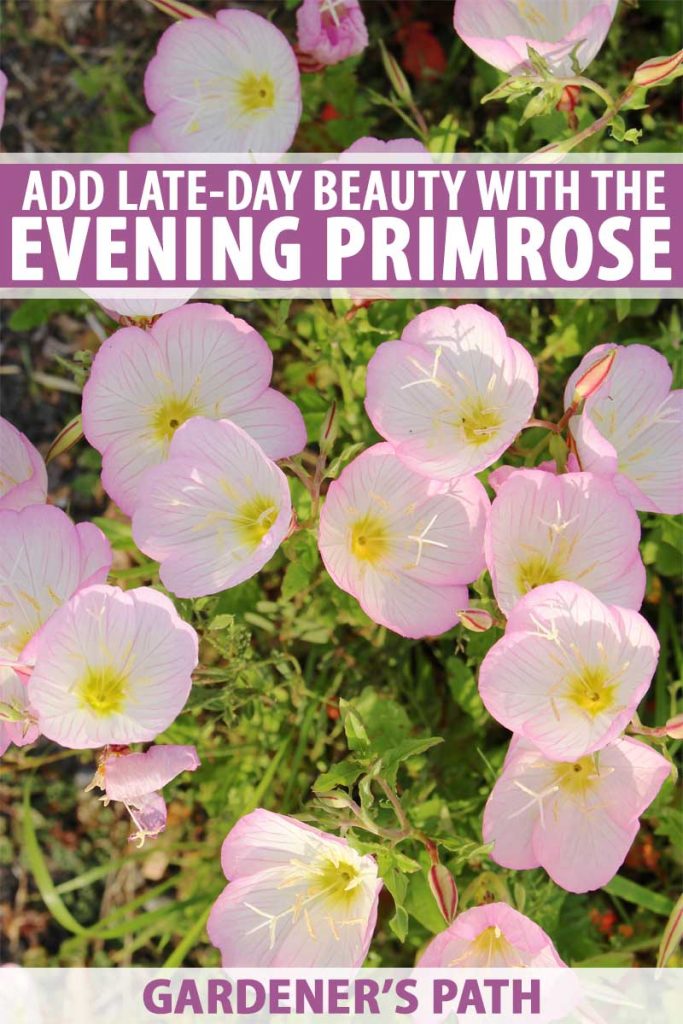

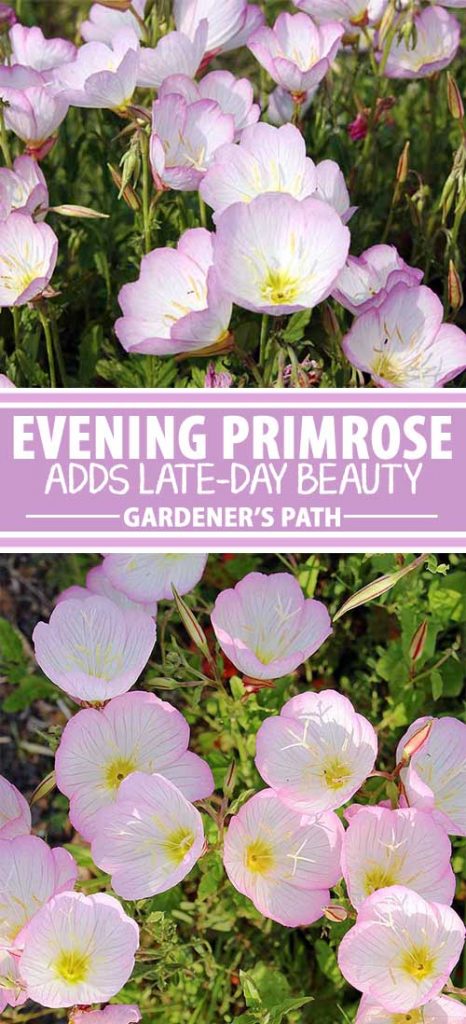
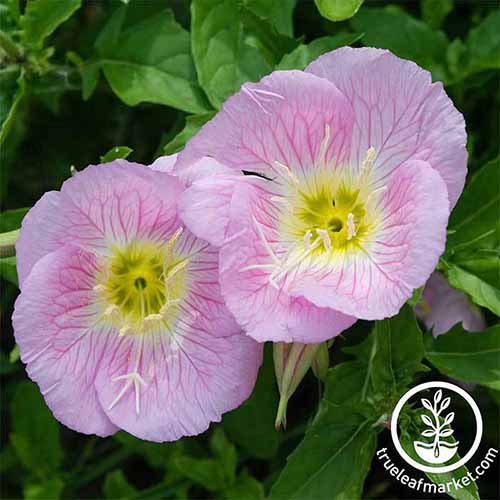
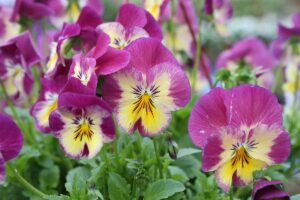

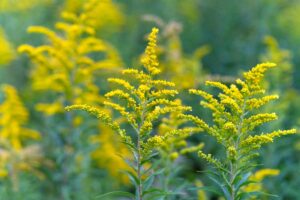
New (to me) plant showed up in my garden this spring. I waited to see what it would appear to be. So now it is 5 ft. tall w/yellow blooms on top. I believed it to be yellow primrose, so looked on the web Sure enough! That’s what I have. Several plants. Lovely…
I also had evening primrose just “show up “. It is now 7 feet tall !!! Lots of leaves ut very few flowers that aren’t even opening. I have no idea from where it came !!!
Thanks for the information. We have primrose everywhere in central TX. (Aus-TX)
Thought I’d share a photo I took.
Beautiful! I love the way they’re catching the light. 🙂
Yes! I live in Southwest Austin and I see them growing wild at the park across the street from my house.
I am told that these types of flowers are a wonderful attraction for bees who are drawn to the nectar within the flower. Is this true?
Indeed! Bees do appreciate the sweetness the flowers offer. Evening primrose also attracts butterflies and particularly, moths.
I inherited a clump of yellow evening primrose but have had no success propagating them from seed. What is the germination time from seed?
Hi Allen… thanks for reading! The germination time can be quite long… as many as 30 days, so perhaps that is the issue?
Gretchen, I am entranced by your site, and your energetic and lighthearted bio! I will look forward to keeping in touch — and am especially happy that you’re in Texas, where I lived and worked for quite a few years in the 1970s — and first became familiar with the evening primrose, which I loved to see, as I drove to dog shows at the crack of dawn and then again home in the evening.
Blessings!!!
Hi Phyllis! What a lovely comment! We’re so glad you’ve found Gardener’s Path and are enjoying the articles. Definitely, please stay in touch! And let us know if there’s a plant we’ve haven’t covered that you’re interested in learning more about.
We have had much rain in NY and my primrose have fallen over and causing some to dry out making my flower bed look unkempt. Can or should I top/trim them for more blooms or just to look neat?
Yes! Absolutely! Trim them back and they will come back more tidily.
I bought a Mexican evening primrose but heard it can be quite invasive – is that true? I have it in a flower bed with other perennials and don’t want it to take over everything , I am not sure if I should move it now to a different location
Hi Jenny! Yes, they can be a bit invasive, depending on which variety you’ve planted. Oenothera speciosa, for example, can be quite invasive.
Should I deadhead my evening primroses so that they continue to bloom all summer?
Thanks for reading this article, Mary Ellen! Yes, do indeed deadhead your evening primrose for more blooms!
I have a Ospeciosa. It was beautiful I transplanted it as it was given to me in a tub. Now it doesn’t bloom. What could I have done to it. I am new to plants and gardening I enjoy it, but sad my evening primrose not doing well.
In what part of the garden did you transplant it? Does it get enough sun?
So strange…I have one plant doing well. Blooming like mad, And one 6′ away from it with no blooms and the leaves are turning red. Any idea what’s up? Thanks!
Hi Lisa! Thanks for reading. Are both pages the same age? Younger plants often have red leaves.